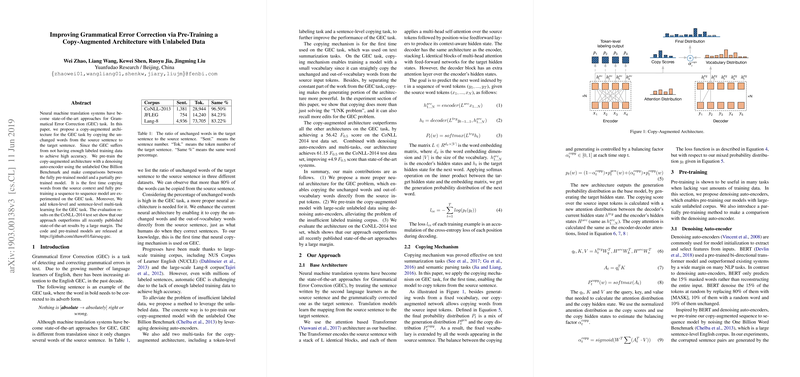Enhancing Grammatical Error Correction with Pre-Trained Copy-Augmented Architectures
The presented paper discusses advancements in Grammatical Error Correction (GEC) through the implementation of a novel copy-augmented neural architecture. The core contribution lies in the introduction of a mechanism that allows for seamless copying of unchanged words from the source to the target sentence, which has been shown to improve performance significantly on GEC tasks. This methodology addresses challenges such as the scarcity of labeled data by utilizing pre-training with unlabeled corpora, specifically leveraging the One Billion Benchmark dataset in conjunction with denoising auto-encoders.
Key Methodological Innovations
- Copy-Augmented Architecture: This approach integrates a copying mechanism into an attention-based Transformer model to directly replicate tokens from the source sentence, leveraging the high occurrence (over 80%) of unchanged words in corrected text. This technique not only addresses the limitation of vocabulary size but also enhances the model's ability to recall accurate corrections.
- Pre-Training with Denoising Auto-encoders: By pre-training on the extensive, unlabeled One Billion Benchmark dataset, the model generalized better, having learned to reconstruct partially corrupted sentences into their unflawed forms. This step helped mitigate the challenge posed by the limited availability of labeled GEC datasets.
- Multi-Task Learning: Introducing token and sentence-level auxiliary learning tasks allowed for a further boost in the model’s performance. Task-specific adjustments enabled the architecture to discern correct sentences and apply a higher propensity for copying when fewer errors were present.
Empirical Outcomes
The evaluation on the CoNLL-2014 test set yielded an apparent superiority of the proposed architecture over existing state-of-the-art models, with the copy-augmented model achieving an score of 56.42 without reranking and increasing to 61.15 when employing denoising pre-training and multi-task learning. These results markedly exceed previous benchmarks by a significant margin, suggesting that the copy-augmented framework substantially enhances GEC operations.
Implications and Future Directions
This paper suggests that GEC systems can significantly benefit from architectures designed to capitalize on structural input consistencies, such as the high ratio of unchanged words between source and target outputs. Furthermore, the successful adoption of pre-training strategies highlights a potential pathway for bolstering GEC capabilities even with limited labeled data.
Looking forward, the enhancement of GEC models will likely involve deeper integration of machine learning techniques and more sophisticated handling of semantic and syntactic characteristics. Models may increasingly exploit hybrid architectures, combining strengths from different paradigms such as statistical and neural methods. Additionally, expanding the accessibility of large-scale and diverse corpora for comprehensive pre-training could also yield further improvements. As GEC systems continue to evolve, these innovations will contribute to the development of even more robust and adaptable LLMs applicable to educational technologies and language learning tools.
